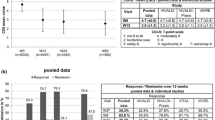Abstract
Antidepressant effects of mirtazapine and imipramine were compared in a randomized, double blind, fixed blood-level study with in-patients in a single centre. Patients with a DSM-III-R diagnosis of major depression and a Hamilton (17-item) score of ≥18 were selected. After a drug-free and a placebowashout period of 7 days in total, 107 patients still fulfilling the HRSD criterion of ≥18, started on active treatment. The dose was adjusted to a predefined fixed blood level to avoid suboptimal dosing of imipramine. Concomitant psychotropic medication was administered only in a few cases because of intolerable anxiety or intolerable psychotic symptoms. Eight patients dropped out and two were excluded from analyses because of non-compliance; 97 completed the study. According to the main response criterion (50% or more reduction on the HRSD score) 11/51 (21.6%) patients responded on mirtazapine and 23/46 (50%) on imipramine after 4 weeks’ treatment on the predefined blood level. Such a dramatic difference in efficacy between antidepressants has not often been reported before. The selection of (severely ill) in-patients, including those with suicidal or psychotic features, may have significance in this respect. Optimization of treatment with the reference drug imipramine through blood level control, exclusion of non-compliance for both drugs, exclusion of most concomitant medication and a low drop-out rate may also have contributed. It is concluded that imipramine is superior to mirtazapine in the patient population studied.
Similar content being viewed by others
References
Angst J (1993) Severity of depression and benzodiazepine comedication in relationship to efficacy of antidepressants in acute trials. Hum Psychopharmacol 8: 401–407.
Angst J, Bech P, Boyer P, Bruinvels J, Engel R, Helmchen H, Hippius H, Lingjaerde O, Racagni G, Saletu B, Sedvall G, Silverstone JT, Stefanis CN, Stoll K, Woggon (1989) Consensus conference on the methodology of clinical trials of antidepressants. Zurich. March 1988: report of the consensus committee. Pharmacopsychiatry 22: 3–7.
American Psychiatric Association (1987), Diagnostic and statistical manual of mental disorders, 3rd edn, revised (DSM-III-R). The American Psychiatric Association Press, Washington DC
Ansseau M (1992) The Atlantic gap; clinical trials in Europe and the United States. Biol Psychiatry 31: 109–111
Bech P (1988) A review of the antidepressant properties of serotonin re-uptake inhibitors. Adv Biol Psychiatry 17: 58–69.
Claghorn JL, Lesem MD (1995) A double-blind placebo controlled study of Org 3770 in depressed outpatients. J Affect Disord 34: 165–171.
Danish University Antidepressant Group (1986) Citalopram: clinical effect profile in comparison with clomipramine. A controlled multicentre study. Psychopharmacology 90: 131–138.
Danish University Antidepressant Group (1990) Paroxetine: a selective serotonin reuptake inhibitor showing better, tolerance, but weaker antidepressant effect, than clomipramine in a controlled multicentre study. J Affect Disord 18: 289–299
Dawling S (1988) Monitoring of tricyclic antidepressant therapy. Clin Biochem 15: 56–61
De Boer Th, Mauri G, Raiteri M, de Vos CJ, Wieringa J, Pinder RM (1988) Neurochemical and autonomic pharmacological profiles of the 6-aza-analogue of mianserin, ORG 3770 and its enantiomers. Neuropharmacology 27: 399–408.
Hamilton M (1960) A rating scale for depression (HRS). J Neurol Neurosurg Psychiatry 23: 56–61.
Kooyman AR, Zwart R, Vanderheyden PML, Van Hooft JA, Vijverberg HPM (1994) Interaction between enantiomers of mianserin and ORG 3770 at 5-HT3 receptors in cultured mouse neuroblastoma cells. Neuropharmacology 33: 501–510.
Marttila M, Jaaskelainen J, Jarvi R, Romanov M, Miettinen E, Sorri P, Ahlfors U, Zivkov M (1995) A double-blind study comparing the efficacy and tolerability of Org 3770 and doxepin in patients with major depression. Eur Neuropsychopharmacol 5: 441–446
Montgomery SA, Asberg MA (1979) A new depression scale designed to be, sensitive to change. Br J Psychiatry 134: 382–389
Paanakker JE, Van Hal HJM (1987) Capillary gas chromatographic assay for routine monitoring of the antidepressant meperzepine in human plasma. J Chromatogr 417: 203–207
Perry PJ, Pfohl BM, Holstad SG (1987) The relationship between antidepressant response and tricyclic antidepressant plasma concentrations: a retrospective analysis of the literature using logistic regression analysis. Clin Pharmacokinet 13: 381–391
Potter WZ, Rudorfer MV (1989) Antidepressants.: a comparative review of the clinical pharmacology and the therapeutic use of the ‘newer’ versus the “older” drugs. Drugs 37: 713–738.
Richou H, Ruimy P, Charbaut J, Delisle JP, Brunner H, Patris M, Zivkov M (1995) A multicentre, double-blind, clomipramine-controlled efficacy and safety study of Org 3770. Hum Psychopharmacol 10: 263–271
Smith WT, Glaudin V, Panagides J, Gilvary E (1990) Mirtazapine vs amitriptyline vs placebo in the treatment of major depressive disorder. Psychopharmal Bull 26: 191–196.
Spitzer RL, Endicott J (1978/79): Schedule for affective disorders and schizophrenia (SADS). Research Assesment and training Unit, State Psychiatric Institute. New York
Spitzer RL, Endicott J, Robins E (1978) Research diagnostic criteria (RDC): rationale and reliability. Arch Gen Psychiatry 35: 773–782.
Van Moffaert M, De Wilde J, Vereecken A, Dierick M, Evrard JL, Wilmotte J, Mendlewicz J (1995) Mirtazapine is more effective than trazodone: a double-blind controlled study in hospitalized patients with major depression. Int Clin Psychopharmacol 10: 3–9
Zivkov M, De Jong G (1995) Org 3770 vs amitriptyline: a 6-week randomized double-blind multicentre trial in hospitalised depressed patients. Hum Psychopharmacol 10: 173–180.
Author information
Authors and Affiliations
Rights and permissions
About this article
Cite this article
Bruiin, J.A., Moleman, P., Mulder, P.G.H. et al. A double-blind, fixed blood-level study comparing mirtazapine with imipramine in depressed in-patients. Psychopharmacology 127, 231–237 (1996). https://doi.org/10.1007/BF02805998
Received:
Accepted:
Issue Date:
DOI: https://doi.org/10.1007/BF02805998




